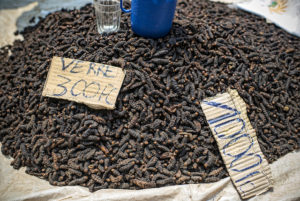
By Jack Hewson, originally published at CIFOR’s Forests News
New study examines how bushmeat is evolving from forest to garden hunting, and from a food staple to a wedding delicacy in the Ecuadorian Amazon.
Getting married can be an anxious affair. One may worry about different sets of friends or family getting along, or if your best man drinks one glass too many and gives an inappropriate speech. Any number of embarrassments might befall you.
In the Amazonian cities and towns of Ecuador, an additional concern is proving that you can provide enough dishes made from bushmeat during the wedding to satisfy the expectation of all invitees, particularly those of your close relatives.
“For this reason, wedding planners have to be connected to sophisticated network of suppliers and to know how to request bushmeat using cell phones and even apps to an illegal product of great cultural significance among Ecuadorian Amazonians,” said Miguel Pinedo-Vasquez, the leading author of a recent study on bushmeat conducted under the CGIAR Research Program on Forests, Trees and Agroforestry.
MODERN MOVEMENT

Modernity has brought less reliance on the forests for Ecuador’s urban and rural population in Amazonia, with many migrating to the cities for work.
When it comes to protein, farmed poultry and livestock are now more regularly consumed, but bushmeat has retained its traditional value for social events, particularly weddings.
Overhunting of large-bodied game and the illegal nature of bushmeat meat are incentives for managing game species (particularly small-bodied species) in production landscapes dominated by smallholder agriculture fields, fallows and forest patches.
“We found that the risk of declining on game populations results more from the loss of habitat and the growth of road networks and other infrastructure that is putting humans closer to populations of game species, even within protected areas,” Pinedo-Vasquez said.
The Napo province is rapidly undergoing a transition to a more mosaic landscape. Today, it boasts the highest urban population density and road infrastructure of any province in the Ecuadorian Amazon.
These changes have had significant impacts on species in areas now more easily accessed by forest hunters, with large-bodied game being significantly depleted. Pinedo-Vasquez and his colleagues have found that the decline of game populations in forests have emerged as an incentive for managing game species in agriculture landscapes and for practicing garden hunting.
What’s more, women become hunters, particularly of small-game species that are managed or protected in fallows, fields, or their house gardens.

While there have been no known extinctions in Amazonia due to the bushmeat trade, there are concerns that unsustainable hunting could prompt local extinctions, particularly of large-bodied species. Such risk seems to be reduced by integrating game management in production landscapes, as is the case of the Napo province.
TRUE TARGETS
To promote sustainable practices and lessen the impact of hunting, Pinedo-Vasquez’s research offers a number of recommendations including: greater coordination between conservation organizations and rural communities, the targeted conservation of depleted species, and monitoring of off-takes coordinated between law enforcement and hunters.
“Crucially, there needs to be engagement with smallholders and indigenous peoples – on a household scale and on a landscape scale,” Pinedo-Vasquez said.
“On a landscape scale, people have to get together and decide when to hunt and what to hunt. Hunting is not a random thing; it’s an issue of local governance.”
For instance, local people are actively enforcing rules governing garden hunting while they are increasingly less interested in enforcing rules governing forest hunting, particularly in areas near or within protected areas.
RECOGNIZE, REGULATE AND REPLICATE
By comparison, Pinedo-Vasquez’s research suggests that less severe measures are required in Ecuador, and he actually recommends three “Rs” for sustainable hunting and bushmeat procurement in the Ecuadorian Amazon.
First, “recognize” the process and patterns of changing landscapes for bushmeat, including the decline of forest hunting and increase of garden hunting. Also recognize the dependence shift from large-bodied to small-bodied game species of bushmeat. Recognize as well that there are more women than men hunters.
Secondly, “regulate” and monitor the sale of bushmeat by species and origin.
Finally, “replicate” the experiences of sustainable game management and the enforcement of rules controlling the hunt, sale and consumption of bushmeat. Certification might be an incentive for replicating good practices in the Amazonian Ecuador. The urban tradition of featuring bushmeat on the wedding menu could be an incentive for the sustainable hunting and sale of bushmeat.
BUSHMEAT AS FUSION FARE?
With lessening of concerns for the survival of Ecuador’s indigenous fauna, Pinedo-Vasquez himself has tried the local bushmeat cuisine.
“While the tradition of eating bushmeat is local, it’s a globalized society. The preparations that people come up with are very varied. You could have peccary with Japanese sauce,” he said.
“I’m really surprised how television has influenced the preparation of bushmeat, but has not eliminated it from the tradition.
“On a recent research field trip, a guy gave me some dried meat with cabbage and it was delicious. When I asked him where he got the recipe from, he said he had learnt it from a British cooking show.











